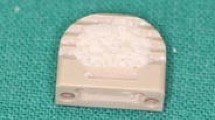Abstract
The surgical technique of anterior vertebral arthrodesis has been modified by the introduction of cages in spinal surgery. The classical technique recommends removal of the vertebral endplate and exposure of bleeding cancellous bone. However, after the observation of cage subsidence during postoperative follow-up, the vertebral endplate is no longer removed, due to its greater mechanical resistance which can prevent cage subsidence. The mechanical characteristics of the vertebral endplate are well known, in contrast to its osteogenic potential, which was investigated in the present experimental study. The study was conducted on mongrel dogs of both sexes, which were submitted to anterior corpectomy at the cervical spine level. A cortico-cancellous bone graft removed from the tibia was used for the reconstruction of the vertebral segment, which was used with osteosynthesis plates. At the site of contact between the surface of the vertebral body and the bone graft, the vertebral endplate was completely removed and cancellous bone was exposed in the inferior vertebra, whereas in the superior vertebra of the arthrodesed vertebral segment only curettage was performed, and the vertebral endplate was preserved, as recommended for cage implantation. Twenty adult dogs of both sexes were divided into four experimental groups according to time of sacrifice (15, 30, 90, and 180 days). The consolidation of the bone graft with the vertebral body was evaluated by histology using hematoxilin-eosin and Gomori trichrome staining. In the interface between the bone graft and the vertebral body surface in which the vertebral endplate was not removed, graft consolidation was not observed in any of the group I animals (sacrificed after 15 days), and was observed in 1/5 animals of group II (30 days), in 2/5 animals of group III (90 days), and in 4/5 animals of group IV (180 days). In the interface between the graft and the vertebral body in which the vertebral endplate was removed, bone-graft consolidation was observed in all animals of all experimental groups (15, 30, 90, and 180 days). Bone-graft consolidation with the surface of the vertebral body was influenced by the removal or maintenance of the vertebral endplate. Due to the importance of this structure in current surgical procedures, this phenomenon deserves to be studied in more detail in order to understand the basic events involved in this process.




Similar content being viewed by others
References
Bailey RW, Badgley CE (1960) Stabilization of the cervical spine by anterior fusion. J Bone Joint Surg Am 42:565–594
Coventry MB, Ghormley RK, Kernohan JW (1945) The intervertebral disc its microscopic anatomy and pathology. J Bone Joint Surg 27:105–112
Hollowell JP, Vollmer DG, Wilson CR, Pintar FA, Yoganandan N (1966) Biomechanical analysis of thoracolumbar constructs. How important is the endplate? Spine 21:1032–1036
Kettler A, Wilke HJ, Claes L (2001) Effects of neck movements on stability and subsidence in cervical interbody fusion: an in vitro study. J Neurosurg 9a(Suppl):97–107
Lim TH, Kwon H, Jeon CH, Kim JG, Sokolowski M, Natarajan R, An HS, Anderssson GB (2001) Effect of endplate conditions and bone mineral density on the compressive strength of the graft-endplate interface in anterior cervical spine fusion. Spine 26:951–956
Moore, RJ (2000) The vertebral endplate what do we know? Eur Spine J 9: 92–96
Smith GW, Robinson RA (1958) The treatment of certain cervical spine disorders by anterior removal of the intervertebral disc and interbody fusion. J Bone Joint Surg Am 40:607–624
Steffen T, Tsantrizos A, Aebi M (2000) Effect of implant design and endplate preparation on the compressive strength of interbody fusion constructs. Spine 25:1077–1084
Zdeblick TA, Cook ME, Wilson D, Kuzn DN, McCabe R (1993) Anterior cervical discectomy, fusion and plating. A comparative animal study. Spine 18:1974–1983
Acknowledgment
This study was supported by a grant from CNPq (Conselho Nacional de Desenvolvimento Científico e Tecnológico-Brasil).
Author information
Authors and Affiliations
Corresponding author
Additional information
Research carried out in the Department of Biomechanics, Medicine and Rehabilitation of the Locomotor Apparatus, Faculty of Medicine of Ribeirão Preto, University of São Paulo, Av. Bandeirantes, 3900, 14048-900 Ribeirão Preto, SP, Brazil.
Rights and permissions
About this article
Cite this article
Porto Filho, M., Pastorello, M. & Defino, H. Experimental study of the participation of the vertebral endplate in the integration of bone grafts. Eur Spine J 14, 965–970 (2005). https://doi.org/10.1007/s00586-004-0826-x
Received:
Accepted:
Published:
Issue Date:
DOI: https://doi.org/10.1007/s00586-004-0826-x




